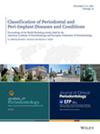Triglyceride glucose index and periodontitis: A nationwide study
IF 4.2
2区 医学
Q1 DENTISTRY, ORAL SURGERY & MEDICINE
引用次数: 0
Abstract
BackgroundNon‐insulin‐based insulin resistance indices provide a cost‐effective assessment of insulin resistance. As periodontitis has a bidirectional relationship with diabetes, this study used these indices to analyze the association between insulin resistance and periodontitis and compared their diagnostic accuracy.MethodsThe study used healthcare big data from the Korea National Health and Nutrition Examination Survey (KNHANES, 2013–2018). Periodontitis was determined based on the Community Periodontal Index (CPI). Among the indices, triglyceride to high‐density lipoprotein cholesterol ratio (TG/HDL‐C), metabolic score for insulin resistance (METS‐IR), triglyceride glucose index (TyG), TyG adjusted with body mass index, TyG adjusted with waist circumference (WC), and TyG adjusted with waist‐to‐height ratio (WHtR) were compared. A multivariate logistic regression model was constructed by dividing the data into quartiles, and receiver operating characteristic (ROC) analysis was performed to compare the diagnostic accuracy.ResultsThe prevalence of periodontitis increased with increasing quartile of the insulin resistance index. The multivariate logistic regression analysis showed that insulin resistance and periodontitis were significantly associated in the fourth quartile for all indicators (甘油三酯葡萄糖指数与牙周炎:一项全国性研究
背景:非胰岛素为基础的胰岛素抵抗指数提供了胰岛素抵抗的成本效益评估。由于牙周炎与糖尿病有双向关系,本研究利用这些指标分析胰岛素抵抗与牙周炎的相关性,并比较其诊断准确性。方法采用韩国国家健康与营养检查调查(KNHANES, 2013-2018)的医疗保健大数据。根据社区牙周指数(CPI)确定牙周炎。其中,比较了甘油三酯与高密度脂蛋白胆固醇比值(TG/HDL‐C)、胰岛素抵抗代谢评分(METS‐IR)、甘油三酯葡萄糖指数(TyG)、随体重指数调整的TyG、随腰围调整的TyG和随腰高比调整的TyG。将数据分成四分位数,建立多元logistic回归模型,并进行受试者工作特征(receiver operating characteristic, ROC)分析比较诊断准确率。结果牙周炎患病率随胰岛素抵抗指数的升高而升高。多因素logistic回归分析显示,胰岛素抵抗与牙周炎在所有指标的第四个四分位数中均显著相关(p <;0.05)。其中,经WHtR调整后的TyG的曲线下面积(AUC)值最高,为0.64,说明其在比较指标中诊断准确率最高。结论TyG相关指标与牙周炎的患病率相关,经WHtR调整后的TyG对牙周炎的诊断准确性最高。这项研究利用韩国22994人的数据,研究了甘油三酯葡萄糖指数(TyG)与牙周炎之间的关系。TyG有助于识别胰岛素抵抗,这是一种身体对胰岛素反应不佳的情况,而胰岛素对控制血糖水平至关重要。与需要血液样本且耗时的传统测试不同,TyG更简单、更便宜。我们的研究发现了胰岛素抵抗和牙周炎之间的联系。在不同版本的TyG中,将TyG与腰高比(TyG*WHtR)结合起来的TyG在识别可能患有牙周炎的人方面是最准确的。这意味着使用TyG*WHtR可能是一种有效的方法,可以发现并帮助那些有胰岛素抵抗风险的人,并有可能在早期改善他们的口腔健康。
本文章由计算机程序翻译,如有差异,请以英文原文为准。
求助全文
约1分钟内获得全文
求助全文
来源期刊

Journal of periodontology
医学-牙科与口腔外科
CiteScore
9.10
自引率
7.00%
发文量
290
审稿时长
3-8 weeks
期刊介绍:
The Journal of Periodontology publishes articles relevant to the science and practice of periodontics and related areas.
 求助内容:
求助内容: 应助结果提醒方式:
应助结果提醒方式:


